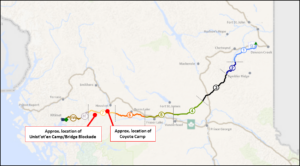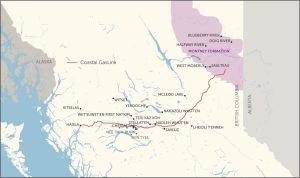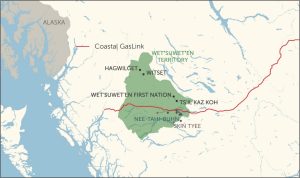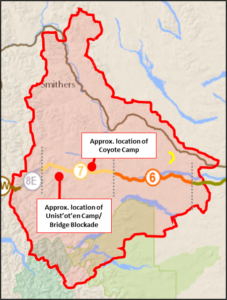Coastal GasLink Pipeline Conflict
LEARNING MODULE
The conflict between the Wet’suwet’en Nation and the Coastal GasLink pipeline has attracted national attention, and deservedly so. The crossing of the pipeline through the traditional territory of the Wet’suwet’en (yintah) is a conflict between Indigenous rights to govern land, government policies and priorities (e.g., environment versus economic development), corporate interests, and police. This situation also highlights differences between the traditional governance of traditional lands by Hereditary Chiefs and the statutory limits of First Nations Bands, which are creations of the Indian Act.
Learning Module
The full scope of the conflict over the Coastal GasLink pipeline cannot be covered within this Learning Module. The aim is to provide a general description of the situation and to highlight major sources of tension. Content includes a description of the pipeline and of different perspectives of the pipeline, including TC Energy, Wet’suwet’en Hereditary Chiefs, and First Nations of the Wet’suwet’en. A list of chronological events since 2012 covers some of the incidents and arrests that have occurred between the RCMP and Wet’suwet’en Land Defenders[1].
About the pipeline
The Coastal GasLink pipeline began in 2020 and is currently under construction at a cost of about $40 billion. The purpose of the pipeline is to transport natural gas from the oil and gas fields in northeast British Columbia (BC) near Dawson Creek to a liquid natural gas facility located on the central west coast near Kitimat. The gas facility, owned by LNG Canada, will convert the gas to a liquid form and export the liquid natural gas to global markets. The pipeline is approximately 670 kilometres long and will deliver 2.1 billion cubic feet per day (bcf/d) of natural gas with the potential to deliver up to 5 bcf/d. Figure 1 illustrates the route of the pipeline, which goes over mountain passes, crosses salmon-bearing rivers, and overlaps many Indigenous territories. As shown on the map, the project to build the pipeline is divided into eight sections, numbered from Section 1 in the east to Section 8 in the west. Figure 2 shows the location of First Nations along the route. Figure 3 shows the pipeline crossing about 190 kilometres of the 22,000 square-kilometre Wet’suwet’en traditional territory and the location of First Nations within the territory. This part of the pipeline corresponds with Sections 6, 7, and 8 of the route, as shown in Figure 4.
Figure 1. Route of the Coastal GasLink pipeline

Figure 2. Location of First Nations along the pipeline route

Figure 3. Section of pipeline crossing Wet’suwet’en traditional territory

Figure 4. Wet’suwet’n territory and location of pipeline route

As of November 28, 2023, according to TC Energy’s update, the pipeline achieved mechanical completion. This completion includes Section 7, the section of the pipeline where most of the conflict is taking place. Mechanical completion includes the safe completion of construction, successful hydro-testing of the entire route, and appropriate engineering reviews.
Perspective: TC Energy
The following information is drawn from TC Energy (2023), Coastal GasLink: Project Overview.
TC Energy is the corporation building the Coastal GasLink pipeline. The pipeline is operated as a separate company, Coastal GasLink Pipeline Ltd. The design of the pipeline began in 2012 with the environmental assessment process completed between 2014 and 2020. According to TC Energy, the route of the pipeline was approved with consideration for a broad set of interests, including Indigenous, landowner and stakeholder input, the environment, archaeological and cultural values, land use compatibility, safety, constructability, and economics.
Coastal GasLink maintains that the pipeline offers a safe means to transport natural gas while also meeting strict environmental standards and providing significant economic benefits to the province. These economic benefits include the following:
- 6,000 high-quality jobs during construction;
- $1.5 billion in employment and contracting opportunities for local and Indigenous communities;
- $21 million in annual property tax benefits; and,
- $11+ million invested in communities to date with investments continuing throughout the life of the project.
To ensure that Indigenous people benefit from the Coastal GasLink pipeline, TC Energy states it is committed to a collaborative approach. TC Energy cites the 20 shared benefits agreements they have signed with First Nations along the route. Sixteen of these First Nations recently signed agreements with TC Energy for an option to purchase a 10 per cent ownership stake of the project. However, the pipeline does not cross the territories of any of these First Nations.
The approved route through the Wet’suwet’en territory is the site of greatest conflict, especially the crossing of the Wedzin Kwa (Morice River) in Section 7. TC Energy’s position is that the specific route of Section 7 presents the only feasible option to connect with Section 8, which is a difficult, remote mountainous terrain.
Perspective: Wet’suwet’en Hereditary Chiefs
Although some elected Band Councils along the pipeline route signed agreements with TC Energy, the Wet’suwet’en’s Hereditary Chiefs oppose the pipeline and did not consent to the project. As confirmed by the Supreme Court of Canada in 1997, the Wet’suwet’en and Gitxsan have rights and title to the land of their traditional territories. Accordingly, the Wet’suwet’en assert that Coastal GasLink, its employees, and contractors are trespassing on their land while the Province is issuing permits illegally.
To the Wet’suwet’en, access to their traditional lands is essential for their social, physical, cultural, and economic well-being. Their territory is a sacred place of cultural sites and for the Wet’suwet’en to hunt, gather medicinal plants and berries, and fish. The Wedzin Kwa (translated as blue-green river) is a sacred waterway that provides clean drinking water and sustenance.
While Band Councils have authority over Reserve lands, the Hereditary Chiefs govern the use of the Wet’suwet’en traditional territory. Accordingly, the Government of BC engaged Wet’suwet’en Hereditary Chiefs (through the Office of the Wet’suwet’en) during the environmental assessment process to establish the route for the pipeline. The aim was to reach an agreement for the route; however, the negotiations were not successful.
Perspective: First Nations within Wet’suwet’en territory
There are six First Nations located on Reserve lands within the Wet’suwet’en territory: Hagwilget, Witset (formerly known as Moricetown), Wet’suwet’en First Nation (formerly known as the Broman Lake Indian Band), Skin Tyee, Ts’il Kaz Koh, and Nee-Tahi-Buhn. Together, the area of land covered by the six Reserves account for 35 square kilometres of the 22,000 square kilometres of Wet’suwet’en territory. The Band Council for each First Nation, established under the Indian Act, has statutory authority over Reserve lands, and no authority over any of the traditional territory.
Five of the six Band Councils signed agreements with TC Energy and the province. The agreements signed with TC Energy are confidential. As reported by Matt Simmons, the agreements with the Province are public and show that the Bands received an initial payment with a promise of additional payments. Simmons wrote, “By supporting the project the nations agreed ‘not to bring any court actions or proceedings that directly or indirectly challenge any government actions in relation to the natural gas pipeline project on the basis that the province has infringed any … rights recognized and affirmed’ by the Constitution Act.”
Hagwilget refused to sign an agreement; their interests align with the Hereditary Chiefs.
“Hagwilget really acknowledges the hereditary system, and the inherent title and right that comes with it. Hagwilget knows its place within that and that’s certainly not in making decisions over land and territory outside of the reserve boundary.”
Source: Simmons, Matt (Oct. 5, 2022). The complicated truth about pipelines crossing Wet’suwet’en territory. The Narwhal.
Tunnelling under the Wedzin Kwa (Morice River)
Natural gas is often promoted as a green source of energy. However, this claim has been disputed, as natural gas is a major source of green house gas emissions. s well, oil and gas pipelines cannot be separated from the source of production, all of which are embedded in a global economy predicated on the extraction of fossil fuels. The Coastal GasLink pipeline is part of this global picture. At its source, the pipeline is connected to the Montney Formation, a source of oil and gas that spans northeast BC and northwest Alberta. The Montney Formation is a major source of shale gas extracted through the controversial method of fracking. At this point, the Montney Formation is at its early stages of development and the Coastal GasLink pipeline to the west coast will help connect this resource to the global market.
When complete, Coastal GasLink’s 670-kilometre pipeline will cross about 625 streams, creeks, rivers, and lakes. To date, TC Energy has been fined $456,200 for environmental infractions, such as protecting fish habitat. One river of major concern to the Wet’suwet’en is the Wedzin Kwa (Morice River). The river, a migration route for salmon, is a sacred waterway for the Wet’suwet’en people. The pipeline threatens this river as a source of sustenance, cultural heritage, and drinking water. The route of the pipeline crosses the Wedzin Kwa. To traverse the river, TC Energy tunnelled under the river using a method called trenchless micro-tunnelling (see Text Box below).
The Wet’suwet’en are deeply concerned about tunnelling under the Wedzin Kwa, which is why this construction site has been a focal point of conflict, as noted below in the list of incidences and arrests. The Coyote Camp is located a short distance from the drilling site.
On April 12, 2023, Coastal GasLink self-reported that two clay deposits at the Wedzin Kwa tunnel site were found. The clay is used as part of the tunnelling process. When not properly contained, the clay is a threat to the environment.
Events: Protests and arrests
The construction of the pipeline through the Wet’suwet’en territory has been countered by on-going efforts by members of the Wet’suwet’en to defend their rights to govern the land. A heavy presence by the RCMP has contributed to many clashes and arrests. The following is a partial account of activities and outcomes, in chronological order.
Sources:
Events listed 2012 through 2019 are from the Supreme Court of BC decision to allow an injunction. Coastal GasLink Pipeline Ltd. v. Huson, 2019 BCSC 2264.
Details of more recent events are from various newspaper articles published in The Tyee, CBC News, and The Narwhal
| Early 2012 | Land defenders set up the Bridge Blockade across the Wedzin Kwa (Morice River) to prevent industrial development, including pipelines, in Unist’ot’en traditional territories. Also known as the Wedzin Kwa Checkpoint. Two gates were built, one on either side of the bridge. Several structures and cabins were built and referred to as the Unist’ot’en Camp, which is located near the confluence of the Wedzin Kwah and Gosnell Creek not far from the mouth of Morice Lake. Location: Unist’ot’en Camp, Morice West Forest Service Road |
| After 2012 |
During early stages of the pipeline’s development, TC Energy attempted unsuccessfully to access the area on the far side (west side) of the Bridge Blockade to conduct field work in preparation of Section 8 of the pipeline. This work was required for planning and applying for permits. TC Energy worked around the Bridge Blockade in order to complete field work., rather than confronting the defendants and possibly escalating conflict. Province issues permits to TC Energy to use forest service roads, including Morice, Morice West, and Shea Creek. |
| 2018 | |
| December 14 | Supreme Court of BC grants an interim injunction to prevent Wet’suwet’en land defenders from blockading the Morice West Forest Service Road to prevent access to the area. |
| December 21 |
Interim injunction revised to include all of the Morice FSR. The Bridge Blockade remained in place and fortified with a wooden barricade across the road, barbed wire, and a bus. |
| 2019 | |
| January 7 | RCMP attended the Bridge Blockade to enforce the Interim Injunction and diffuse tensions. The RCMP met with a group of Wet’suwet’en Hereditary Chiefs to discuss voluntary access beyond the Blockade, without success. The same day, the RCMP began to enforce the Interim Injunction with the aim to control the area. In response, Land Defenders ignited a large fire and felled trees across the road. Fourteen Land Defenders were arrested, but charges were vacated later. Access beyond the Bridge Blockade was impeded until January 11, 2019. |
| April 12 | Land Defenders at the Unist’ot’en Camp and TC Energy signed an Access Protocol Agreement. In spite of this agreement, more incidents and work delays followed. As well, “new resistance camps” were established in other areas within Sections 7 and 8. |
| March 2 | The Tsayu Land Defenders established a camp to stop TC Energy from conducting work in the territory of the Tsayu Clan. |
| May 29 | Land Defenders built a Healing Cabin on Crystal Creek Forest Service Road and directly in the path of the pipeline right-of-way.
Ongoing incidents contributed to delays and increased costs to TC Energy. Activities of Land Defenders included the movement and removal of flagging for construction and environmental matters; entering the areas behind safety barriers; parking vehicles in front of heavy machinery; masked people driving a pickup truck into an active work site at a high rate of speed; intimidating behaviour or verbal harassment. |
| December 19 | Supreme Court of BC issues injunction prohibiting anyone from interfering with, stopping, or obstructing Coastal GasLink work activities. |
| 2020 | |
| February | The RCMP removed a series of Wet’suwet’en checkpoints. Dozens of Land Defenders were arrested. |
| February 29 | The Government of Canada, Government of BC, and Wet’suwet’en Hereditary Chiefs signed a Memorandum of Understanding (MOU). The MOU states that Canada and BC recognise recognize Wet’suwet’en aboriginal rights and title throughout the yintah and that these rights and title are held by Wet’suwet’en Houses under their system of governance. Under the terms of the MOU, an agreement was to be negotiated within twelve months. However, shortly thereafter, COVID protocols hindered the negotiations; it appears that negotiations remain on-going. The MOU does no address the CGL pipeline.
After the MOU was signed, the RCMP interventions on Wet’suwet’en traditional territories have continued. |
| May 1 | The Elected Chiefs of the Wet’suwet’en Nations released a letter stating they “have not agreed to, nor have they given their support to sign, a proposed Memorandum of Understanding (MOU) on rights and title with Canada or British Columbia.” The Elected Chiefs expressed concern about not being consulted and that no vote was taken on the MOU. |
|
|
|
| August 15 | A cabin belonging to Chief Gisday’wa was destroyed by fire. The arsonists are unknown. |
|
|
|
| 2021 |
|
| April 16 | The Province of BC announced it will provide $7.2 million over three years to the Wet’suwet’en Nation to support implementing rights and title in their territory. The three-year funding program will help support governance among Wet’suwet’en members and for water stewardship, wildlife programs, eco-system monitoring, other stewardship initiatives, and ongoing discussions related to the 2020 Memorandum of Understanding. |
| November 14 |
After occupying a site along the Wedzin Kwa for 50 days, Land Defenders blocked the road into the territory. The Coyote resistance camp occupies Coastal GasLink’s drill site on the banks of the Wedzin Kwa River. Coastal GasLink workers were given 10 hours to leave, but most workers stayed. |
|
|
|
| November 17 |
Police raided the resistance camp. The raid involved a canine unit, sniper rifles, and helicopters. Police used a chainsaw to gain access to a tiny house. Twelve land defenders and two journalists were arrested. |
|
|
|
| 2022 |
|
| February 17 |
Coastal GasLink security reported a violent confrontation with Land Defenders. |
|
|
|
| June 22 |
Members of the Gidimt’en Clan of the Wet’suwet’en Nation filed a civil claim against the RCMP, the BC Minister of Justice, Coastal Gaslink Pipeline LTD., and private security contractor Forsythe. The claim alleges a campaign of surveillance, intimidation, and harassment. |
|
|
|
| September |
Coastal GasLink says it “is in the process of completing trenchless watercourse crossings underneath the Morice River and Crocker Creek. |
|
|
|
| September 22 |
CGL contractors destroyed an archeological site that is significant to preserving the cultural heritage of the Wet’suwet’en. |
|
|
|
| 2023 |
|
| March 26 |
A Coastal GasLink security worker files complaint with Police, alleging a group of people wearing masks and camouflage gained access to the work area, including vehicles. |
|
|
|
| March 29 |
Five land defender arrested for obstruction of Police. Police were enforcing a search warrant for theft under $5,000 that occurred on March 26. |
Media Attributions
- Figure 1. Route of the Coastal GasLink pipeline
- Figure 2. First Nations along Coastal GasLink Pipeline route © Simmons, Matt (Oct. 5, 2022). The complicated truth about pipelines crossing Wet’suwet’en territory. The Narwhal. is licensed under a All Rights Reserved license
- Figure 3. Section of pipeline crossing Wet’suwet’en traditional territory. © Simmons, Matt (Oct. 5, 2022). The complicated truth about pipelines crossing Wet’suwet’en territory. The Narwhal. is licensed under a All Rights Reserved license
- Figure 4. Numbered sections of pipeline crossing Wet’suwet’en traditional territory
- The term Land Defenders is used often to describe people who are located at resistance camps and blockades as a means to protect the rights and title to land of the Wet’suwet’en Nation. ↵


Feedback/Errata